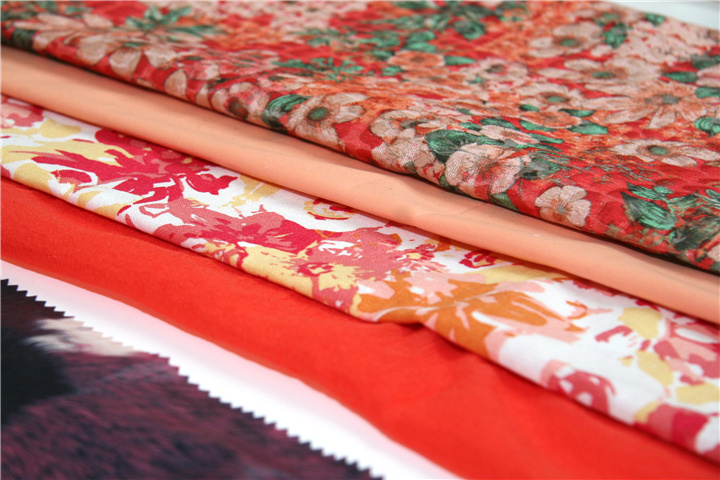Table of Contents
What are the characteristics of transfer printing?
What is transfer printed fabric? Fabric (cloth) printing pigments or dyes on paper, rubber or other carriers, and then transfer printing on the goods to be printed is called transfer printing, but in a narrow sense, transfer printed fabric refers to the transfer printing technology with needle textiles as the carrier.
Transfer printed fabric is mainly used in polyester fiber products. With the improvement of transfer printing, it is also widely used in nylon, acrylonitrile, cotton, hemp and wool products.
Transfer printing fabrics (fabrics) can be divided into wet, dry, steam, vacuum, thermal and other forms.
Transfer printing can accurately reproduce the pattern, facilitate mechanized production, and the process is simple, especially the post-treatment process is simpler than traditional printing and dyeing, and the printing feel is the same as printing and dyeing, so it has the potential to gradually replace the old printing method.
However, in China, most printing and dyeing plants still use the traditional printing and dyeing method, and only a few production units use transfer printing for production.
Transfer printing fabric (fabric) features
- Transfer printed fabric pattern has the characteristics of realistic pattern, detailed pattern, clear level and strong three-dimensional sense.
Transfer printing can print natural scenery and artistic patterns.
- The transfer printed fabric (cloth) equipment has the characteristics of simple structure, small land occupation, less investment and high economic efficiency. Because the equipment is tension-free processing, it is suitable for printing of all kinds of thickness.
In addition, after transfer printing, it can be packaged and delivered without post-treatment.
- There is no environmental pollution problem in transfer printed fabric (fabrics). Due to dry processing, there is no need for water washing, steaming, drying and other processes, so there is no waste gas and wastewater discharge.
- Transfer printed fabric (cloth) has the advantages of high production efficiency, labor saving and simple operation.
At present, the widely used hot-melt resins include polyamide, vinyl acetate copolymer and polyurethane in addition to polyester.
The main component of polyester hot melt adhesive is polyester resin, which is polybasic acid.
Obtained by esterification with polyol. Polyamide hot melt adhesive has strong adhesion, toughness and low temperature resistance, especially good affinity with nylon fabric.
It is suitable for preparing nylon transfer printing paper.
Ethylene vinyl acetate copolymer has low melting point and strong adhesion. It is suitable for the production of transfer printing paper after adding printing ink.
Polyurethane hot melt adhesive is mainly used for gluing leather and polyvinylene plastic.
For transfer printing, due to different fabrics to be printed, it is best to use suitable hot melt adhesive ink.

Principle of transfer printing fabric (cloth)
Transfer printed fabric (fabrics) are mostly used for polyester fabrics. It is a printing method in which the dye is sublimated to vapor phase on the surface of polyester by heating at high temperature (about 200 ℃), then penetrates into the amorphous area of fiber macromolecules, and is fixed in the fiber after cooling.
Requirements for dyes in transfer printed fabrics (fabrics)
For disperse dyes used in transfer printed fabrics, the sublimation temperature should be lower than the melting point of fiber macromolecules and do not damage the fabric strength.
The more suitable processing temperature for polyester is 180-210 ℃.
In this temperature range, the molecular weight of the varieties in which the dye sublimates is between 230-270. There are generally three types of disperse dyes with molecular weight in this range.
Fast dyeing disperse dyes: the color can be sublimated at about 180 ℃, and the color will change with the increase of temperature, and the edge will seep.
Good dispersive dye: the color can be sublimated in the temperature range of 180-210 ℃. The hair color curve is flat. Temperature has little effect on dyeing, so it is a more suitable disperse dye for transfer printed fabrics.
Delayed disperse dyes: dyes cannot sublimate and color well at 180-210 ℃. If the temperature is increased, good hair color can be obtained. This kind of dye is strongly temperature dependent.
According to the above conditions, the dyes suitable for transfer printed fabrics should meet the following conditions:
- the dyes of transfer printing fabrics (fabrics) must be fully sublimated and fixed on the fiber below 210 ℃, and can obtain good washing fastness and ironing fastness.
- After heating, the dye of transfer printing fabric (cloth) can be fully sublimated and transformed into gas-phase dye macromolecules, which condense on the fabric surface and diffuse into the fiber.
- The dyes used in transfer printing fabrics (fabrics) have less affinity for transfer paper and greater affinity for fabrics.
- The dye of transfer printing fabric (cloth) shall have bright and bright color.



